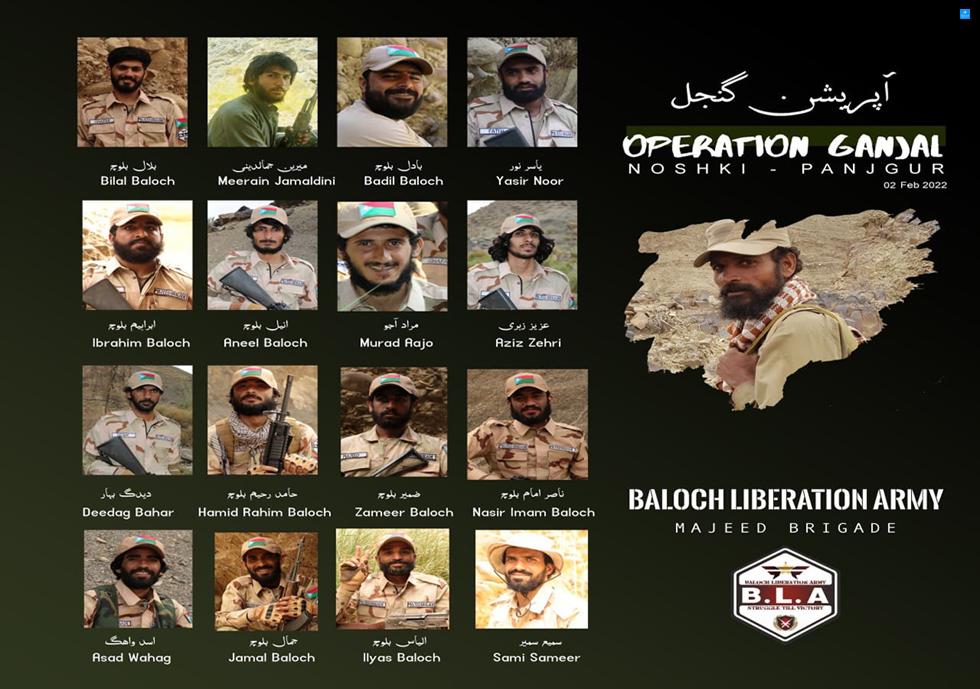Since the beginning of this year, violent attacks by secular ethnic Baluch separatists in Pakistan’s restive southwestern province of Balochistan have dramatically risen. The once ragtag guerrillas relying on “hit-and-run” tactics are now turning to high-profile suicide attacks that cause mass casualties.
Pakistani officials blame regional rivals for the increase in violence in the vast province bordering Iran and Afghanistan and the site of major Chinese projects.
But experts in Balochistan say the spike shows that Islamabad’s failure to resolve or effectively address the long-standing grievances of its ethnic Baluch minority has helped the insurgency to persist and provides an opening for neighbors to interfere.
Successive Pakistani governments and the country’s powerful military have wavered in attempting to crush the separatist militants or combine anti-insurgency tactics with development projects in an effort to address the grievances that fuel violence in the region.
“Even the security establishment is surprised by the spike in violence,” Shahzada Zulfiqar, a veteran journalist in Balochistan’s capital, Quetta, told RFE/RL’s Radio Mashaal. “It proved wrong the diagnosis of the political leadership they had installed here.”
Zulfiqar says pro-military politicians in Balochistan downplayed the gravity of the simmering insurgency by casting separatists merely as disgruntled young men whose grievances could be addressed by development projects promising jobs and stability.
But simple answers have long eluded the resource-rich region. Balochistan entered the limelight last month after shadowy separatist organizations launched a string of high-profile attacks. On January 20, a previously unknown group called the Baloch Nationalist Army (BNA) claimed responsibility for a bomb attack at a market in the eastern city of Lahore that killed two and injured dozens.
On January 27, the Pakistani military said 10 of its soldiers were killed in a firefight in Balochistan’s Kech district. The Baloch Liberation Front (BLF), an established group, claimed responsibility for that attack.
On February 2, more than a dozen fighters attacked two Pakistani paramilitary camps in the remote districts of Panjgur and Naushki along Pakistan’s southern border with Iran and western border with Afghanistan. The Baloch Liberation Army (BLA), an old nationalist militant group that has splintered into factions, claimed that 16 fighters killed scores of Pakistani soldiers in the suicide attacks. The military, however, said only nine soldiers were killed in the firefight and that it killed 20 attackers.
Political Failure
“The surge in violence is a continuation of politics by other means,” says Mohammad Ali Talpur, a columnist who fought during a previous Baluch insurrection in the 1970s. “Repression has increased with the increase in the economic footprint in the region, and the militancy is a response to that.”
Balochistan is home to several major Chinese projects touted as a way to change Pakistan’s economic fortunes and benefit Balochistan by bringing in jobs and investments. The port of Gwadar became the linchpin of the Pakistan China Economic Corridor (CPEC), a collection of multibillion-dollar energy and transportation projects aimed at linking Xinjiang in western China to the Gulf of Oman through Pakistan. Beijing is also involved in mineral extraction in Balochistan.
But Baluch nationalists oppose Beijing’s footprint. Since separatists began attacking Chinese workers in 2004, Islamabad has launched sporadic military sweeps and a continued crackdown on militants and other supporters of the cause. Human rights campaigners accuse Islamabad of forcefully disappearing or extrajudicially killing Baluch activists and militants since the first clashes erupted between nationalist rebels and security forces in 2000.
Anwar Sajidi, editor of Intikhab, a daily in Balochistan, says that instead of addressing the underlying causes of the insurrection, Islamabad has doubled down on supporting pro-military politicians to quell the insurgency — the fifth since Pakistan’s independence in 1947.
“Politicians who have no popular backing are being imposed on the region,” he told RFE/RL. “The character of Balochistan as a province has ended because it is directly controlled.”
Baluch nationalists and some mainstream Pakistani leaders accuse the military of micromanaging the region by supporting politicians and tribal leaders willing to do its bidding. They point to the emergence of the province’s ruling Balochistan Awami Party in 2018 as evidence.
Iran Connection
The military, however, denies having a hand in the region’s affairs. After last week’s attacks, senior officials in Balochistan once again pointed fingers at neighboring countries. Balochistan Home Minister Mir Ziaullah Langov said that while Baluch militants have attracted support from archrival India and elements in Afghanistan, Islamabad is not ruling out the possibility of Iran’s involvement.
“These elements may not necessarily have the support of the state in Iran, but they benefit from links with nonstate actors because of frequent cross-border movement and tribal connections,” Langov told journalists on February 3.
Baluch separatists appear to have lost their erstwhile sanctuary in Afghanistan since the Taliban seized Kabul in August, and experts see an opening for Iran.
“This might be the first time that Iran is sheltering the Baluch insurgents,” Sajdi said. “Afghanistan has always sheltered the Baluch.”
Talpur, however, says the Baluch insurgents are returning home after losing their Afghan sanctuary.
“They now have no option but to fight back,” he said. “They are not supported by Iran’s clerical regime but by the Baluch population in two countries.”
Pakistan’s Balochistan Province borders Iran’s southeastern province of Sistan-Baluchistan, where Sunni Baluch make up the majority of residents. Over the past two decades, the Sunni Baluch group Jandullah and its successor, Jaish-ul Adl, have claimed responsibility for scores of deadly attacks and the kidnappings of Iranian security forces. Unlike the secular Baluch separatists in Pakistan, the Baluch groups in Iran see themselves in a struggle against Iran’s Shi’ite clerical rulers.
Kiyya Baloch, a journalist from Balochistan now exiled in Europe, says Tehran might be paying back Islamabad for its support for anti-Tehran Sunni militants.
“It is likely that Iran is supporting the current rise in violence,” he said. “At the least, they are closing their eyes to the activities of Baluch militants.”
Changing Insurgency
Since 2020, Baluch factions have attacked Pakistani security forces, civilians, and Chinese projects inside the country and have publicly clashed with exiled Baluch nationalist leaders whom Islamabad accused of leading the insurgency after the violence that followed the 2006 killing of Nawab Akbar Bugti, an elderly Baluch politician.
“This is unprecedented,” says Sajdi. “The leadership here accuses the tribal leaders of betraying their cause because they were seen as capable of compromising their [Baluch] interests.”
In 2009, the Baloch Liberation Front (BLF) emerged as the first non-tribal militant group that relied on recruits from the vast Makran region in southern Balochistan. In 2019, the Baluch Raji Ajohi Sangar (BRAS) allied BLF with a faction of BLA and the Baloch Republican Army. While retaining their old names, the groups have undergone leadership changes. These groups now appear to be forging a new path.
“They have concluded that classic guerrilla tactics such as hit-and-run attacks do not attract much attention,” Kiyya Baloch noted. “So they are copying the Taliban and groups in the region,” he added, saying that instead of frequent small-scale attacks, they are now focused on sporadic large attacks such as those last week in Panjgur and Naushki.
Sajdi, the newspaper editor, sees no visible end to the ongoing violence.
“In its absence of a political settlement, violence will continue, and it will end when one side is defeated utterly,” he said.

 Abubakar Siddique, a journalist for RFE/RL’s Radio Azadi, specializes in the coverage of Afghanistan and Pakistan. He is the author of The Pashtun Question: The Unresolved Key To The Future Of Pakistan And Afghanistan.
Abubakar Siddique, a journalist for RFE/RL’s Radio Azadi, specializes in the coverage of Afghanistan and Pakistan. He is the author of The Pashtun Question: The Unresolved Key To The Future Of Pakistan And Afghanistan.